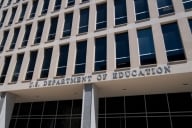You have /5 articles left.
Sign up for a free account or log in.

VioletaStoimenova/E+/getty images
With the onset of the pandemic in March 2020, colleges and universities looked to teaching centers and faculty development specialists to help transition pedagogy so that learning could continue in a manner that made sense given the challenges of a pandemic. Before that, teaching centers were considered beneficial to faculty members, and many had their share of “frequent fliers” who attended all the events.
But in reality, they really did not have an impact on a large percentage of faculty at the institution. Faculty members often viewed the teaching center on their campus as just an add-on that would help if they needed it, or worse, as a place where bad instructors went when they needed help.
All that changed when faculty members had to quickly and efficiently adapt their pedagogy to the new world of teaching remotely or asynchronously. At many institutions, including our university, the teaching center—along with many other units and individuals on the campus that support teaching and learning—worked with faculty across the institution to ensure that courses continued to be taught and students continued to learn. It was a time of “we are going to get through this somehow,” and teaching centers provided the opportunity for faculty members to still deliver content and assess learning in a way that made sense throughout the crisis situation we were in.
As the pandemic has continued to be a factor and we have learned to adapt and mitigate risk, the role of the teaching center has again shifted. But that shift is toward a new reality in which a number of things have become readily apparent.
- Faculty and institutions need to be ready to adapt to changing conditions very quickly, including being prepared to pivot once again should we encounter new challenges.
- Teaching centers can help faculty members create courses that can be adapted to operate under different conditions. A great deal of research shows how faculty can pivot, adapt and still deliver high-quality teaching and learning
- Students will, for many years, be prepared to adapt to changing conditions as well.
- Many of the pedagogical innovations that we developed during the early days of the pandemic worked terribly, like providing students with more independent work without support. At the same time, some worked very well, such as giving students a clearer understanding of the reasons behind the methods being used in the classroom.
- Teaching will never be the same. It will continue to evolve and improve as long as we keep student learning as our goal.
With the changes described above, teaching centers have become even more important on college campuses, as we sit, in fact, at the center of the pedagogical world of the institution. And the time to capitalize on that position at the university is now. Teaching centers should work hard, today more than ever, to help faculty members understand that we actually do know a lot about teaching and learning. And to be an effective instructor, recognizing what we know about how students learn and the variables that impact learning, we need to consider ways of teaching that are novel to us. Yet technology, while trumpeted as the answer, is only a part of the solution.
Now is the time for teaching centers to take a leadership role in the institution and help faculty understand that teaching and learning are distinctly relational processes. And to do that well, we need to know that the unidirectional aspect of teaching is not going to be as effective as teaching that values and leverages student learning in ways that make sense with the data that are coming out of the science of learning.
How can centers do this?
Centers can host a series of conversations with faculty about pedagogy. If open to the conversations, faculty would benefit from carefully considering how they navigate the classroom and beyond. To help faculty members, centers should talk about pedagogy in general, with an emphasis on student engagement. Faculty could learn about the evidence that demonstrates that there are many ways to engage students, and to do so within the framework of their discipline leads to the potential for more student engagement and more effective learning.
Topics for the conversations could include evidence-supported teaching practices (i.e., use of active learning to promote student engagement), or teaching strategies that make use of what we know about student learning (i.e., to learn effectively, students need to have the ability to utilize prior knowledge to incorporate newly learned material). By getting faculty members to begin to realize that we in teaching centers have an understanding of how students learn and how classrooms can be designed to be more effective, we can then help faculty begin to address specifically how to engage students to improve their learning.
Centers can provide specific teaching strategies to faculty—with data to support their efficacy if necessary—to help faculty guide students efficiently and effectively. Those strategies might include workshops on evidence-supported practices such as:
- Retrieval practice: the idea that the more times a student has to reactivate and recall information under different conditions, the better the student can recall under test conditions.
- Interleaving: teaching material, switching to newer material and then returning to the original content. Data demonstrate that reactivating the previously learned material can lead to stronger memory and learning over all.
- Desirable difficulties: providing students with scaffolded problems that can lead to potential failure. Evidence has shown that by creating a situation in which work is required to solve a problem, even if the response is incorrect, the work done leads to more effective learning.
These three strategies have been shown to be incredibly useful for many faculty and lead to more effective memory (retrieval practice), integration (interleaving) and problem solving (desirable difficulties). They are just a few of the specific strategies that would help faculty eventually help students.
Centers can communicate their work and contributions more widely and effectively across the campus. Many centers use newsletters or weekly email blasts as a means of communication. It is important to provide useful and actionable information in those newsletters. Faculty members are so inundated with newsletters and emails that we need to make sure that our messages are also concise, clear and worth reading.
Centers can also help by having open-door policies with faculty to ensure that they are approachable and available. Faculty will undoubtedly need the center at various times, under various conditions. With that in mind, the center should also have multiple access points for contact that include not only the email address for the center, but also perhaps the center director’s email address. It should offer a phone number that is answered by an actual person and a variety of staff members that are around and provide service, so the center looks like—and is—a place where things happen.
Centers can act as liaisons. They can connect students and faculty in ways that help faculty understand student needs and perspectives. Those efforts can take the form of conversations between students and faculty to better understand the others’ perspectives. They can also act as liaisons between faculty and administrators to help those administrators understand what faculty need to be effective instructors.
Centers can partner with colleagues on the campus to provide support for student learning. Those colleagues might include counseling centers, academic support centers, academic advisers and student leaders. For example, centers can co-sponsor events with counseling centers that address issues of mental health on the campus or can lead conversations with new faculty about academic advising. Centers have, traditionally, been the place for only faculty members to talk about teaching. Now is the time for that mission to expand.
The time for teaching centers to shine is now. Center directors’ training has always served a small number of faculty on many campuses. We need to step that up now and broaden our approach to include many more stakeholders. Centers must consider that the main goal of a college or university is to educate students, and that our job is to support that goal. Yet as we have learned so keenly in the last two years, educating a student is not just something that happens in the classroom in a unidirectional manner. We have learned that good teaching and learning require engagement, effort and flexibility. Centers of teaching and learning specialize in understanding how to help students engage effortfully and how faculty can create flexible and effective learning environments. We need to leverage that knowledge across campus by increasing our visibility, and working across different offices is one of the keys to starting that process.
As I have noted, a transparent set of conversations between faculty members and both students and administrators helps guide a deeper understanding of the needs of the institution when it comes to supporting student learning. Teaching and learning on college campuses will undoubtedly improve under these conditions. And along with that, we will continue to provide the kind of education that our students deserve and that our faculty are able to give.
The future of higher education is uncertain, and the challenges we face are enormous. If we continue to focus on the core mission of most institutions, we can continue to thrive and provide the education our students need to succeed. By creating a teaching and learning center that is truly at the core of the mission of the institution, we will help faculty provide the kind of education that will serve our students in both the short and long term.








